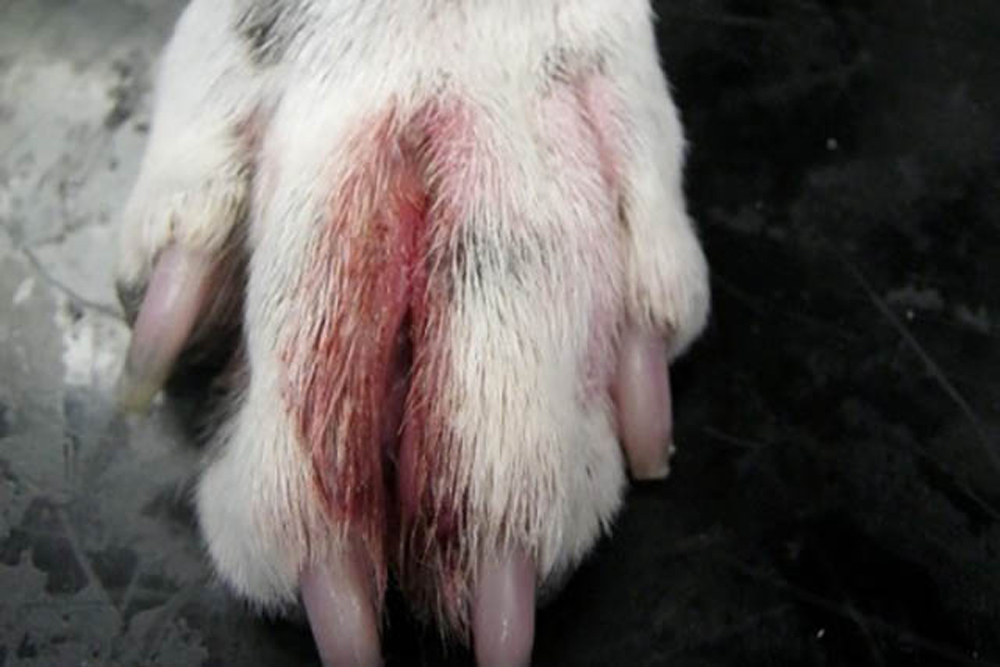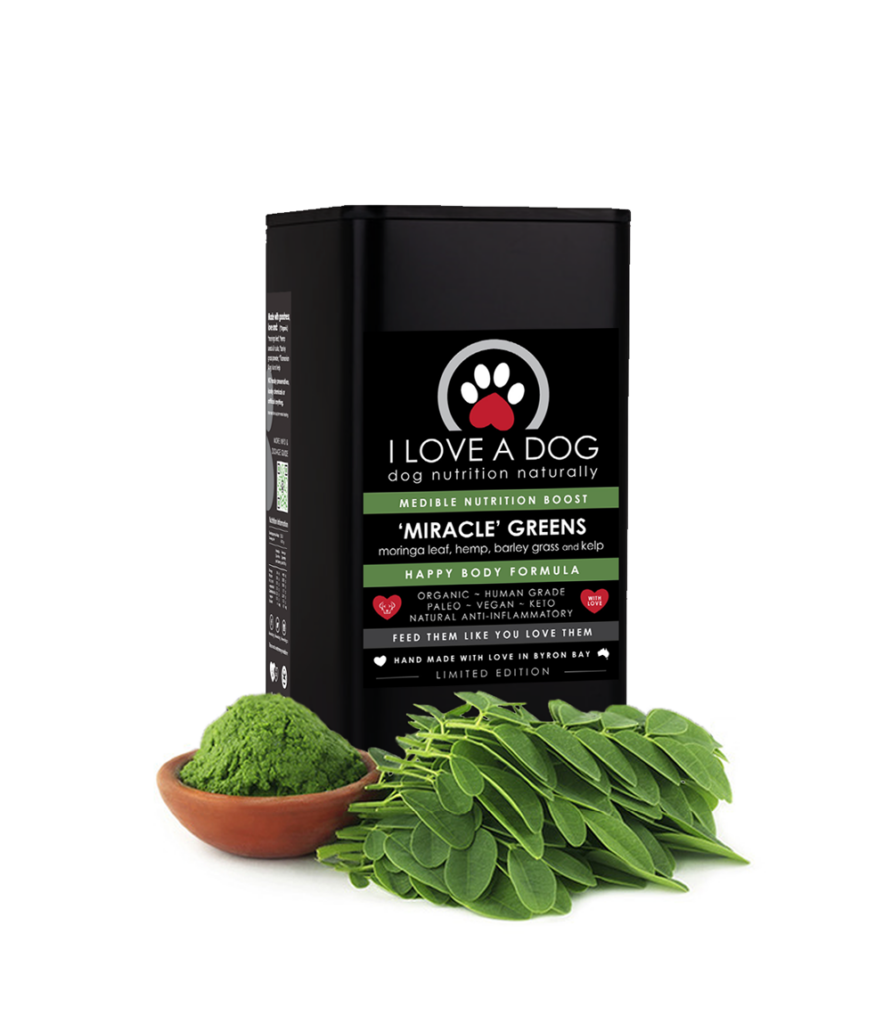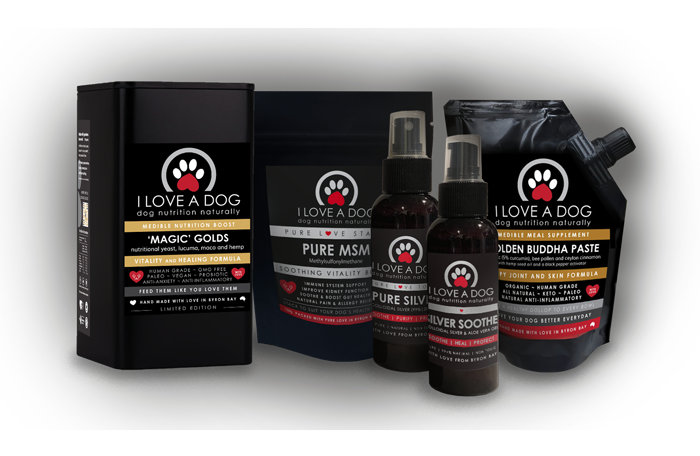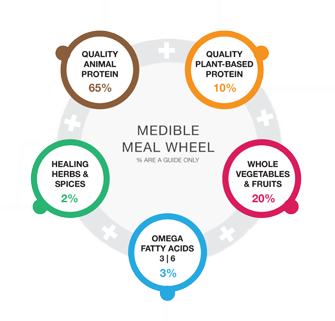What is Atopic Dermatitis?

This article by: Donna Lorenz – Chief Dog Lover | Dog Nutritionist
Atopic Dermatitis (AD) is the name for the clinical condition that is the allergic reaction, usually to environmental allergens but can also be food-related, that manifests as itchy and inflamed skin that causes a dog to rub, lick, bite and scratch the area – often making it worse and leading to secondary infection. It’s angry and itchy and merciless and you’ll want to do just about anything to soothe it and, even better, solve it.
Approx 10% of the world’s dog population presents to the vet with this condition, with some reports of slightly higher incidence in females. Up to 23% may have a concurrent food hypersensitivity.
AD can occur in any breed however increased genetic risk for Golden and Labrador Retrievers (especially if both parents have AD), Pit Bull Terriers, German Shepherds, English Bulldogs, Boxers, Pugs, Irish Setters, Dalmatians, West Highland Scottish Terriers, Wirehair Fox Terriers, Welsh Terriers, Boston Terriers, Cairn Terriers, Lhasa Apsos, Shih Tzus, and Miniature Schnauzers.
There are also variations in how AD typically presents in different breeds eg French Bulldog – eyelids, axilla, WHST – yeast infections, oily and flaky skin, German Shepherd – elbows, paws, groin, hindlegs.
ALD – Atopic-like Dermatitis – presents mostly in French Bulldogs and Bichon Frise.
What is AD?
Atopic dermatitis (AD) is another common cause of skin itching (pruritus) in dogs and is predominantly caused by environmental allergens, food allergens, and ‘microbial colonisation’ of Staphylococcus and Malassezia. It is generally diagnosed by ruling out ‘all other causes of itching’.
This condition is multifactorial and defined as a “genetically predisposed inflammatory and pruritic allergic skin disease often associated with a production of immunoglobulin (Ig) E against environmental allergens” [1].
What causes AD?
While its root cause is still unclear, skin inflammation and irritation from the combination of an ‘aberrant’ immune response and defects in the skin barrier play key roles. This defect in the skin barrier is the primary method of allergen absorption, much more so than inhalation or oral ingestion. This tells us how important skin health is before allergic reactions appear.
https://www.ncbi.nlm.nih.gov/pmc/articles/PMC8603501/
All dogs with AD have abnormal skin barrier function
Skin barrier dysfunction is required for AD to manifest. This dysfunction can be an imbalance of structural components of skin such as ceramides, fatty acids and cholesterol. This impaired barrier function allows ‘excessive transcutaneous absorption of allergens to start the inflammatory cascade as well as increased transepidermal water loss’.
Some use the analogy of the skin barrier as a ‘brick wall’ with the “bricks” being the skin cells and the “mortar” being the lipids, ceramides and fatty acids. Dogs with AD have a “crumbling brick wall” due to decreased or poorly formed “mortar”. Therefore preventing, stopping or fixing that ‘crumbling’ is key to solving the AD problem for any dog. Even better to maintain it from the beginning and avoid AD altogether.
Marsella R, et al. Unraveling the skin barrier: a new paradigm for atopic dermatitis and house dust mites. Vet Dermatol. 2009;20:533-40
What causes the itching sensation?
AD has been primarily thought to be driven by IgE and mast cell degranulation releasing a range of active compounds. While IgE and mast cells definitely play a role, new research shows it’s a little more complex.
Atopic dogs have a reactive immune system of the skin that is weighted to have a pro-inflammatory reaction to allergens that sends a specific message to the cells that triggers the perception of itching. It is thought that this mechanism may be why antihistamines generally don’t work well and why responses with inhibitory effects on T cells, inflammatory cytokines and the JAK enzyme system (which cause the itching) are more effective.
Hygiene Hypothesis
A recent Swiss study found an increased risk in AD for dogs with an urban life and regular bathing from an early age, where dogs with a rural life, who lived with other animals and enjoyed forest walks had a decreased risk or occurrence.
Meury S, et al. Role of the environment in the development of canine atopic dermatitis in Labrador and golden retrievers. Vet Dermatol. 2011; 22:327-334.
https://www.isvma.org/wp-content/uploads/2016/10/AtopicDermatitisPart1.pdf
Secondary infections are often present
To make matters worse, often much worse and sometimes because the initial irritation was left to develop, secondary infections in dogs with AD are common. These infections make the dermatitis worse by both adding to the discomfort in itself as well as by producing endotoxins that act as superantigens producing more inflammatory cytokines and making the whole situation much, much worse and harder to resolve.
Treat allergies early and inside and out
The best treatment for AD is thought to be multifaceted – including allergy avoidance, immune response modulation (or suppression) and strengthening the skin layer. This ideally involves treatments directed at the cause of the reaction, which can be helped by good nutrition with low to no carbs, natural medicines such as medicinal mushrooms, moringa, msm, turmeric and cbd oil, and topical treatments to soothe and heal the irritation, preferably natural and non-toxic.
By understanding the components and antagonists of skin irritation and allergic discomfort we can get to know our dog’s vulnerability and protective needs so that we can respond quickly. By protecting them altogether from allergic reactions or soothing them quickly we can hopefully stop them from evolving into something that requires significant pharma interactions, such as cortisone injections or ongoing antihistamine treatments that have their own adverse side effects.
Solving some allergic responses can be very difficult and the longer they are entrenched the harder they can be to solve so it is vital to take them seriously even before they are severe.
Signs to look for
Most dogs will first show evidence of the disease from 6 months to 3 years. Symptoms may be seasonal or non-seasonal.
Early signs to look for:
- Face rubbing
- Foot licking
- Head shaking
- Scratching ears and armpits
Later signs of AD developing:
- Redness of skin
- Rash and red lumps on skin
- Chronic or recurrent yeast infections
- Ear infections (initially the outer ear then moving the ear canal)
- Bleeding sores from scratching or chewing
NEW DIAGNOSTIC CRITERIA (Favrot Criteria)
Recently a set of diagnostic criteria was developed as a guide to AD. It is advised that this should not replace a thorough history and diagnostic tests to rule out parasites, infections and food-related allergies.
- Age of onset <3 years
- Mostly indoor
- Corticosteroid-responsive pruritus (itchiness)
- Pruritus without skin lesions at onset
- Chronic or recurrent yeast infections
- Affected front feet
- Affected ear pinnae (but not pinnae margins)
- Non-affected dorso-lumbar area
At least 5 positives = 85% sensitivity
Be sure to assess your dog’s sensitivity to allergies and take steps to address and prevent them before they arise. You’ll both be glad you did.
Don’t take your dog’s no allergies status for granted as it can change very quickly and take much longer to get back to balance.
Check out our Allergy Aleve Pack for products in our range that can help.
Soothing the symptoms quickly is obviously important to give our dogs relief (when their discomfort is at its worst I too encourage dog humans to get pharma treatments from their vet while we introduce a natural healing approach) but it’s vital to also address the cause or causes of what is making the dog vulnerable and to minimise negative side effects from treatment.
That generally means:
– soothing inflammation naturally (internally and externally),
– strengthening and modulating the immune system,
– fortifying the skin and the intestinal wall, and
– minimising exposure to allergen/s, gently increasing over time to build resilience
REFERENCES:
Please Note:
The information on this website is presented for educational purposes only. It is not intended as a substitute for the diagnosis, treatment, or advice of a qualified, licensed medical professional. The facts presented are offered as information only, not medical advice, and in no way should anyone infer that we are practicing medicine. Seek the advice of a medical professional for proper application of this material to any specific situation.
No statement on this website has been evaluated by the Therapeutic Goods Association or the Australian Pesticides and Veterinary Medicine Authority. Any product mentioned or described on this website is not intended to diagnose, treat, cure, or prevent any disease. We recommend that you do your own independent research before purchasing anything.
However, we bring this information to you in good faith, after lots of research, with an open heart and good healing vibes. Our mission is to help you and your dog. Feel free to get in touch. Wishing you both much health, happiness and belly rubs.

























